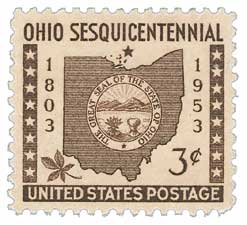
# 3595 - 2002 34c Greetings From America: Ohio
Ohio
34¢ Greetings From America
City: New York, NY
Quantity: 200,000,000
Printed by: American Packaging Corp for Sennett Security Products
Printing Method: Photogravure
Perforations: Serpentine Die Cut 10.75
Quantity: 200,000,000
Ohio And Nebraska Join The Union
Early American Indians known as the Mound Builders lived in Ohio thousands of years ago. When Europeans first reached this area, they found Indians from the Delaware, Miami, Shawnee, and Wyandot (also known as the Huron).
History credits France’s Rene-Robert Cavelier, titled Sieur de La Salle, as the first European to visit Ohio in 1669. In fact, France claimed the entire American Northwest, based on La Salle’s explorations. However, the British claimed all of the land west of their Atlantic colonies, which included this area. Land ownership disputes resulted in the French and Indian War, which lasted from 1754-63. The British were victorious, and France relinquished most of its land claims west of the Mississippi.
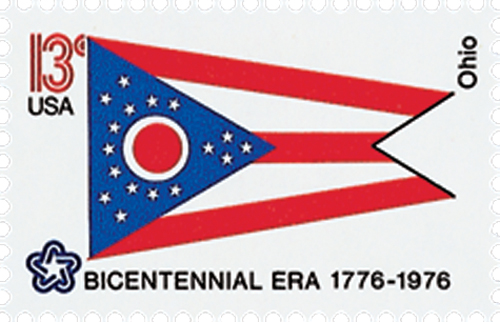
Some of the fighting of the American Revolutionary War took place in Ohio. In 1780, troops under George Rogers Clark defeated the Shawnee Indians, who were allies of the British, at the Battle of Piqua. Clark’s victories in the Northwest were instrumental in securing the territory for the U.S. during the Revolution.
Ohio became part of the Northwest Territory in 1787. That year, the Northwest Ordinance passed, which provided the foundation for granting Ohio and other territories statehood. On April 7, 1788, the Ohio Company of Associates established Marietta, the first permanent European settlement in Ohio. That July, Marietta became the first capital in the Northwest Territory. Veterans of the American Revolution were rewarded for their service with land grants. Many of these veterans began settling along the Ohio River. For several years, Indian attacks disturbed the growth and prosperity of the settlements. Then, in 1794, General Anthony Wayne defeated the Indians at the Battle of Fallen Timbers. With peace restored, even more settlers moved to the region.
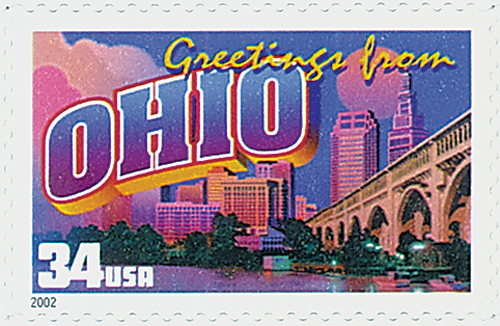
In 1800, the Division Act created the Indiana Territory out of the western part of the Northwest Territory, which was given the new capital of Chillicothe. In 1802, a convention met in Chillicothe to create a constitution in preparation for statehood. On March 1, 1803, Ohio became the 17th state to join the Union. The capital city changed several times during a relatively short period. First it was Chillicothe, then Zanesville, then Chillicothe again, and then Columbus – the present-day capital.
Now let’s take a trip west and follow Nebraska’s path to statehood…
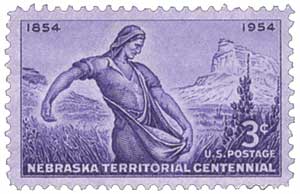
Scientists believe humans may have lived in Nebraska as long as 25,000 years ago. When the first Europeans arrived in the area during the early 1700s, they found several American Indian tribes including the Missouri, Omaha, Otoe, Ponca, Pawnee, Sioux, Arapaho, and Cheyenne.
Though both France and Spain claimed the territory that included Nebraska as early as 1541, the first Europeans to set foot there didn’t arrive until nearly 200 years later. That likely occurred in 1739, when French explorers, brothers Pierre and Paul Mallet, traveled from Illinois to Santa Fe.
In 1803, the United States bought the vast Louisiana Territory, which included Nebraska, from France. President Thomas Jefferson sent an expedition led by Meriwether Lewis and William Clark to explore the Louisiana Territory in 1804. During their journey, Lewis and Clark explored the eastern portion of Nebraska. Explorer Zebulon M. Pike reached south-central Nebraska in 1806. From 1807 to 1820, the Spanish-American trader Manuel Lisa established several fur trading posts along the Missouri River. These included Fort Lisa, located about 10 miles from the site of today’s Omaha, Nebraska.
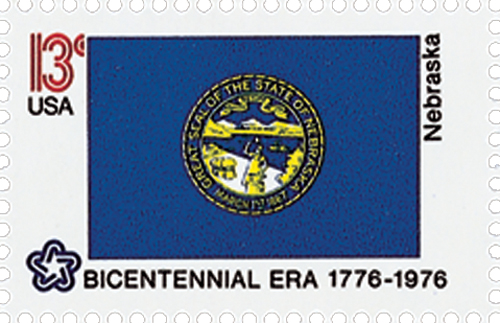
In 1819, the U.S. Army built Fort Atkinson on the Missouri River. This fort included Nebraska’s first school, library, sawmill, gristmill, and brickyard. Army Major Stephen H. Long led an expedition along the Northern Platte and Platte River valleys. Long declared the areas “unfit for farming,” calling it the “Great American Desert.”
Despite the establishment of fur trading posts, Nebraska was considered Indian land and was not available for settlement. Then, Congress passed the Kansas-Nebraska Act in 1854, creating these two territories and making them available for settlement. These territories would have been established earlier, but disagreements over slavery prevented Congress from doing so. Northerners wanted to ban slavery from new territories, while Southerners wanted to permit it. The Kansas-Nebraska Act allowed the people of the new territories to decide for themselves. The vast majority of Nebraskans were opposed to slavery.
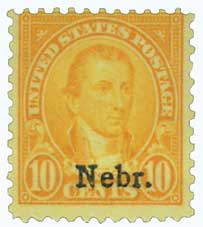
In 1854, the Nebraska Territory included the land of the state of Nebraska and parts of Montana, North Dakota, South Dakota, Wyoming and Colorado. Then in 1862, Congress passed the first Homestead Act, which granted 160 acres of free land to western settlers. Thousands of people came to settle in Nebraska. Congress created several new territories out of this larger territory, and by 1863, Nebraska was about its current size. The Union Pacific and Burlington railroads built lines through Nebraska, and advertised its farmland to people in the East and in Europe. By 1870, Nebraska had a population of 122,993 people.
On March 1, 1867, Congress admitted Nebraska to the Union, overriding President Andrew Johnson’s veto. Republican David Butler was elected the state’s first governor. President Johnson, a democrat, had opposed Nebraska’s statehood, as he believed the republican state’s two senators would allow impeachment proceedings, which were already in progress, to convict him.
Ohio
34¢ Greetings From America
City: New York, NY
Quantity: 200,000,000
Printed by: American Packaging Corp for Sennett Security Products
Printing Method: Photogravure
Perforations: Serpentine Die Cut 10.75
Quantity: 200,000,000
Ohio And Nebraska Join The Union
Early American Indians known as the Mound Builders lived in Ohio thousands of years ago. When Europeans first reached this area, they found Indians from the Delaware, Miami, Shawnee, and Wyandot (also known as the Huron).
History credits France’s Rene-Robert Cavelier, titled Sieur de La Salle, as the first European to visit Ohio in 1669. In fact, France claimed the entire American Northwest, based on La Salle’s explorations. However, the British claimed all of the land west of their Atlantic colonies, which included this area. Land ownership disputes resulted in the French and Indian War, which lasted from 1754-63. The British were victorious, and France relinquished most of its land claims west of the Mississippi.

Some of the fighting of the American Revolutionary War took place in Ohio. In 1780, troops under George Rogers Clark defeated the Shawnee Indians, who were allies of the British, at the Battle of Piqua. Clark’s victories in the Northwest were instrumental in securing the territory for the U.S. during the Revolution.
Ohio became part of the Northwest Territory in 1787. That year, the Northwest Ordinance passed, which provided the foundation for granting Ohio and other territories statehood. On April 7, 1788, the Ohio Company of Associates established Marietta, the first permanent European settlement in Ohio. That July, Marietta became the first capital in the Northwest Territory. Veterans of the American Revolution were rewarded for their service with land grants. Many of these veterans began settling along the Ohio River. For several years, Indian attacks disturbed the growth and prosperity of the settlements. Then, in 1794, General Anthony Wayne defeated the Indians at the Battle of Fallen Timbers. With peace restored, even more settlers moved to the region.

In 1800, the Division Act created the Indiana Territory out of the western part of the Northwest Territory, which was given the new capital of Chillicothe. In 1802, a convention met in Chillicothe to create a constitution in preparation for statehood. On March 1, 1803, Ohio became the 17th state to join the Union. The capital city changed several times during a relatively short period. First it was Chillicothe, then Zanesville, then Chillicothe again, and then Columbus – the present-day capital.
Now let’s take a trip west and follow Nebraska’s path to statehood…

Scientists believe humans may have lived in Nebraska as long as 25,000 years ago. When the first Europeans arrived in the area during the early 1700s, they found several American Indian tribes including the Missouri, Omaha, Otoe, Ponca, Pawnee, Sioux, Arapaho, and Cheyenne.
Though both France and Spain claimed the territory that included Nebraska as early as 1541, the first Europeans to set foot there didn’t arrive until nearly 200 years later. That likely occurred in 1739, when French explorers, brothers Pierre and Paul Mallet, traveled from Illinois to Santa Fe.
In 1803, the United States bought the vast Louisiana Territory, which included Nebraska, from France. President Thomas Jefferson sent an expedition led by Meriwether Lewis and William Clark to explore the Louisiana Territory in 1804. During their journey, Lewis and Clark explored the eastern portion of Nebraska. Explorer Zebulon M. Pike reached south-central Nebraska in 1806. From 1807 to 1820, the Spanish-American trader Manuel Lisa established several fur trading posts along the Missouri River. These included Fort Lisa, located about 10 miles from the site of today’s Omaha, Nebraska.

In 1819, the U.S. Army built Fort Atkinson on the Missouri River. This fort included Nebraska’s first school, library, sawmill, gristmill, and brickyard. Army Major Stephen H. Long led an expedition along the Northern Platte and Platte River valleys. Long declared the areas “unfit for farming,” calling it the “Great American Desert.”
Despite the establishment of fur trading posts, Nebraska was considered Indian land and was not available for settlement. Then, Congress passed the Kansas-Nebraska Act in 1854, creating these two territories and making them available for settlement. These territories would have been established earlier, but disagreements over slavery prevented Congress from doing so. Northerners wanted to ban slavery from new territories, while Southerners wanted to permit it. The Kansas-Nebraska Act allowed the people of the new territories to decide for themselves. The vast majority of Nebraskans were opposed to slavery.

In 1854, the Nebraska Territory included the land of the state of Nebraska and parts of Montana, North Dakota, South Dakota, Wyoming and Colorado. Then in 1862, Congress passed the first Homestead Act, which granted 160 acres of free land to western settlers. Thousands of people came to settle in Nebraska. Congress created several new territories out of this larger territory, and by 1863, Nebraska was about its current size. The Union Pacific and Burlington railroads built lines through Nebraska, and advertised its farmland to people in the East and in Europe. By 1870, Nebraska had a population of 122,993 people.
On March 1, 1867, Congress admitted Nebraska to the Union, overriding President Andrew Johnson’s veto. Republican David Butler was elected the state’s first governor. President Johnson, a democrat, had opposed Nebraska’s statehood, as he believed the republican state’s two senators would allow impeachment proceedings, which were already in progress, to convict him.








